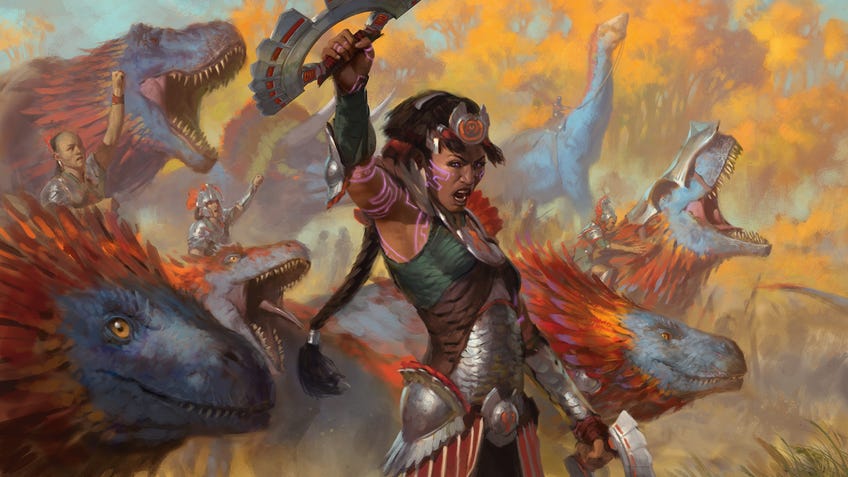Magic: The Gathering’s The Lost Caverns of Ixalan is a resplendent return to a fascinating plane
Everybody do the dinosaur.
The Lost Caverns of Ixalan takes Magic: The Gathering back to the plane where Jace and Vraska ignited the spark of romance between them. It’s where Jace was flung after getting his butt whooped by Nicol Bolas and, with his memory lost, he found himself finally actually lifting instead of just using illusions to look like he did.
It’s not just story relevance though; Ixalan is a fascinating plane all around because it’s filled with dinosaurs, merfolk, pirates and vampires. It’s basically the kind of set you’d get if you allowed a 10-year-old to design creature types - and we mean that in the most sincere and complimentary way possible.
The return to the set sees even more incredible references to Mesoamerican civilizations too, with some of the gods feeling evocative of that pantheon of deities. Take Ojer Pakpatiq, Deepest Epoch, an enormous serpent-like being with colourful wings and a tail that goes on forever. It’s easy to see the influence of Quetzalcoatl in the design, which adds to the gravitas of the god in the game. Ojer Axonil, Deepest Might also has a dinosaur for an arm, which is badass. Not as weighty as Quetzalcoatl, for sure, but you simply have to love the design.
Outside of the visual side of things, Lost Caverns of Ixalan’s cards have some intriguing mechanics, which reference the Age of Discovery along with the world of the dead. We’ve got the return of transforming double-face cards and Explore, which lets you draw cards or put +1/+1 counters on a creature depending on the card you reveal from your library.
In terms of the new mechanics, that’s where things get really interesting. Craft is a variation on transforming cards, allowing you to spend mana and a specific card type (or number of card types) to transform your card.
It’s basically the kind of set you’d get if you allowed a 10-year-old to design creature types - and we mean that in the most sincere and complimentary way possible.
Take The Enigma Jewel, a one-mana artifact that allows you to tap it to gain two mana to spend on activated abilities. For nine mana, plus four or more nonland cards with activated abilities, you can transform it into the Locus of Enlightenment, which reads: “Locus of Enlightenment has each activated ability of the exiled cards used to craft it. You may activate each of those abilities only once each turn. Whenever you activate an ability that isn’t a mana ability, copy it. You may choose new targets for the copy.”
The other exploration-themed mechanic is Discover. Discover is a numbered ability that allows you to exile cards from the top of your library until you hit a card with a mana value of X or less. You can then either cast that spell for free or put it into your hand. It’s a lot like Cascade, if a little bit less abusable. We love casting spells for free, and the ability to put them into your hand instead is a nice bonus for spells with specific timing requirements.

Now we move onto the underworld-themed mechanics. The less exciting of the two is the introduction of finality counters. Any permanent with a finality counter on its card is exiled instead of going into the graveyard. This concept has long been a thing in MTG anyway, so this is more Wizards of the Coast encoding it into a handy phrase rather than a truly new mechanic.
It’s hard not to be charmed by so many cool creature types.
Descend is the other mechanic in The Lost Caverns of Ixalan, and it’s all about the graveyard. Descend comes in a few flavours, but the long and short of it is that it cares about the number of permanent cards in your graveyard. One of the cuter examples in the set is the Basking Capybara, a two-mana card that gets +3/+0 as long as you have four or more permanent cards in your graveyard. There’s also Descended, which is when you put a permanent into your graveyard from anywhere else.
The mechanics are a nice thematic fit, and feel powerful enough to see some play in a few formats, especially Commander, but not so absurd that they’ll be easily exploited. This is pretty key when you consider that Wizards of the Coast had to actually change how Cascade works back in 2021 because it became completely unfair.
With the new mechanics and excellent card designs, The Lost Caverns of Ixalan is a very good Magic: The Gathering set. It’s hard not to be charmed by so many cool creature types and, while the plane still feels like one built specifically to satisfy Commander players with typal obsessions - which, to be fair, is most Commander players - the power balance of the cards is a lot more in line with other formats.
There are still a few too many variations in every set, which isn’t an issue specific to The Lost Caverns of Ixalan, but does almost feel more egregious here as we’ve been putting up with it for so long.
On the whole, The Lost Caverns of Ixalan is a strong MTG set that should satisfy all manner of players. We just wish it had a little bit more time to breathe. We literally had Tomb Raider card previews land the same week it’s releasing, and our “first look” at Murders at Karlov Manor is coming in just three weeks' time on December 5th. Magic: The Gathering sets simply don’t have room to blossom anymore. That continues to be a shame, given how good a lot of the recent sets feel.









